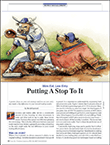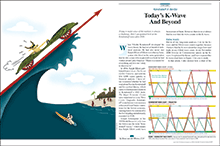Letters To The Editor
July 2011 Letters To The Editor
The editors of S&C invite readers to submit their opinions and information on subjects relating to technical analysis and this magazine. This column is our means of communication with our readers. Is there something you would like to know more (or less) about? Tell us about it. Without a source of new ideas and subjects coming from our readers, this magazine would not exist.
Address your correspondence to: Editor, Stocks & Commodities, 4757 California Ave. SW, Seattle, WA 98116-4499, or E-mail to editor@traders.com. All letters become the property of Technical Analysis, Inc. Letter-writers must include their full name and address for verification. Letters may be edited for length or clarity. The opinions expressed in this column do not necessarily represent those of the magazine. —Editor

PUTTING A STOP TO IT
Editor,
Very interesting article by David Garrard in the May 2011 S&C about the use of stops. Preservation of capital is an important element in any trade.
After reading the article, I had several points that did not seem to be covered:
- Regarding Figure 2, how were the tight, medium and loose stops calculated? The author makes reference to “dynamic volatility and an evaluation of standard deviations” but there are no hints on how this number is calculated.
- For the 14-day Atr, how does the author suggest applying this number to the stock price? Do I use a multiple of the Atr like 2 or 2.5? Do I simply calculate the 14-day Atr daily and apply it to each different closing price? Another way to look at it is, how frequently do I calculate and change the Atr?
Loved the article but the actual application is vague. Thank you for a fantastic publication.
Jeff
David Garrard replies:
Regarding how the tight, medium, and loose stops are calculated: Recognia (www.recognia.com) uses a proprietary algorithm to generate a “filter line.” You can find out more about filter lines in a book by Recognia’s chief scientist, Chris Satchwell, titled Pattern Recognition And Trading Decisions. From this, Recognia calculates the standard deviation and specifies “tight” as one standard deviation, “medium” as two, and “loose” as three. We are using 150 bars for the standard deviation calculation.
Regarding Atr, I have often seen reference in other literature to following the closing price with a 2.5 times Atr trailing offset. I would suggest that if you recalculate that offset once a week, as a casual trader, it would be appropriate. If the character of the price action of the stock changes dramatically, then you would want to update it immediately.
Editor’s note: David Garrard is VP, Asia-Pacific, for Recognia Inc.

GAP FILL AND GO
Editor,
I truly enjoyed Jamie Theiss’ article in the May 2011 S&C. I find his technique to be simple, uncomplicated, and very effective. I find it to be one of the best trading methods out there.
Thank you for his article.
David
GAP FILL AND GO QUESTION
Editor,
Thank you for Jamie Theiss’ article in the May 2011 S&C, “Gap Fill and Go.”
I employed it to my success the other day for the first time, going short one stock while going long another. My question is, how do you find the stocks that are opening on a gap? Also, your two examples showed what looked like ordinary gaps. Do you stay away from larger gaps, or do larger gaps work just as well?
Seth Okun
Jamie Theiss replies:
Right — the two examples are ordinary gaps. For larger gaps and flat openings I use different techniques, such as fading larger gaps and igniting bars from flat openings. Remember, there might be days when no setups are found, and having the discipline to not trade on such days is very important. As far as finding them, I used to use a scanner but found I was missing too many entries and chasing others. So what I did was follow Jesse Livermore’s advice, which is, “Better to watch too few than too many.”
Now I have a watchlist of 20 stocks that I monitor closely and really trade only eight to 12 on a day-to-day basis. This way, I can start to learn the unique characteristics and patterns of these stocks and not chase the entire market.
GAP FILL AND GO (FADE THE GAPS)
Editor,
Excellent article by Jamie Theiss in the May 2011 S&C. Nearly all my trades are done by fading the gaps right after the opening using one-minute candlesticks plus a couple of indicators. Occasionally, I will wait around after my exit and look for a continuation back in the direction of the gap, as Theiss describes in his article, and that works too. I’m done by 10:30 at the latest every day. His article was very timely for me because I’ve been thinking about staying around longer more often. Thanks for the encouragement.
Pete

ELLIOTT WAVE
Editor,
Thank you for Koos van der Merwe’s contribution to the April 2011 issue of Technical Analysis of Stocks & Commodities. I have found myself gravitating more and more towards the work of R.N. Elliott, and I think van der Merwe’s work has put me over the top.
Craig